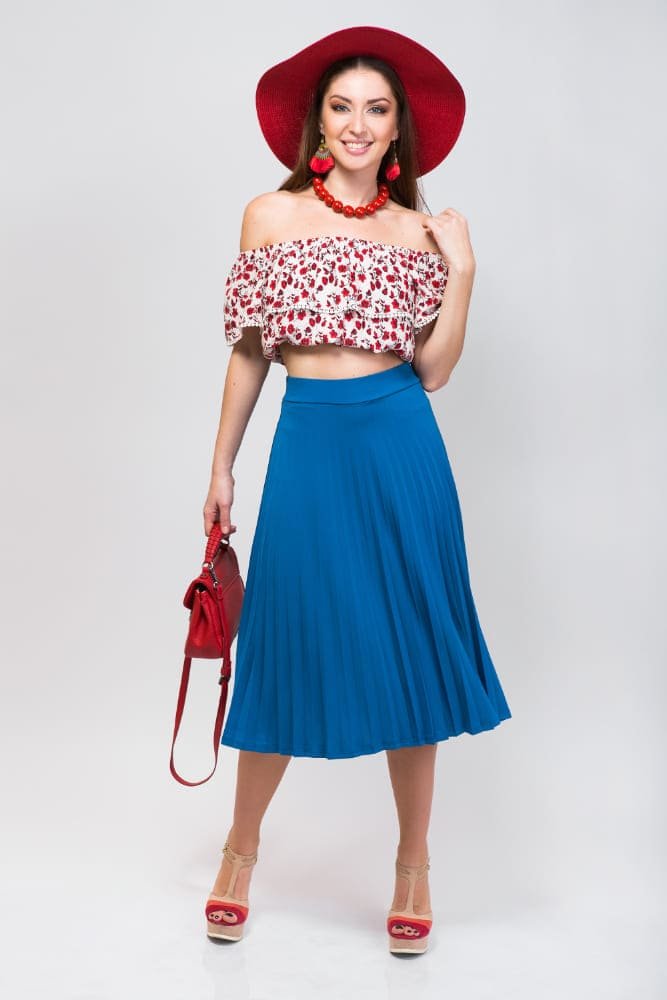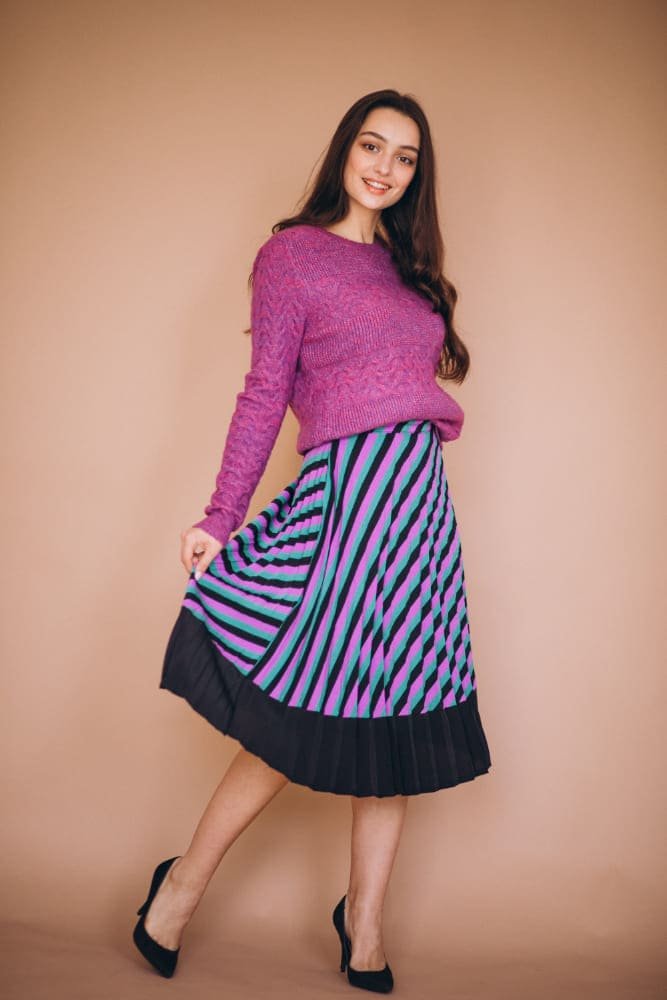Inside Article
Skirts Seen as Women’s Clothes
In many cultures, skirts have been seen as a symbol of femininity and are primarily associated with women’s clothing. However, this association is largely based on societal norms and expectations rather than any inherent qualities of the garment itself. In this article, we will discuss why skirts are often perceived as women’s clothing and how this perception has evolved.
They are more than just fabric; they are a canvas for personal expression, a nod to centuries of tradition, and a marker for social and individual significance. Join me as we explore the myriad reasons why women have embraced skirts, from ancient Mesopotamian civilizations to the high-street fashion statistics of today. Skirts are stitched into the fabric of femininity, and here’s why they are not just a fashion choice, but a lifestyle.
The Indomitable Attraction to skirts

Whether for a casual outing or a formal event, skirts have always enjoyed a unique position in women’s closets. They are the epitome of versatility, offering an ever-fresh canvas that can swiftly transition from a morning office meeting to an evening of flamenco. The appeal is as multifaceted as the garment itself. Here’s a deep dive into the irresistibility of skirts:
Sheer Comfort and a Whisper of Breeze
Skirts champion sheer comfort, giving women a respite from the snug confines of trousers. It’s not just about physical ease; it’s a mental reset, a sartorial sigh of relief. The gentle sway with each step is a personal refrain, a part of womanhood’s unvoiced poetry.
Decoding Elegance One Length at a Time
There’s an unmatched elegance to skirts. They allow women to express their femininity in a language all their own. Whether it’s the sleek lines of a pencil skirt or the ethereal grace of maxis represent the finer strokes that women add to their daily canvases.
A Bottomless Pit of Styles and Pairings
One can never tire of the many styles and pairings skirts offer. They are sartorial chameleons, adapting effortlessly to any theme or motif. From casual denim skirts paired with sneakers to the grandeur of formal skirts set off by the sheen of a silk blouse, the possibilities are endless.You can also wear a red skirt with different outifits.
.Championing Individualism and Taste
A skirt is a statement, a voice in the choir of personal style. It’s an opportunity to say, “This is who I am,” without uttering a word. With skirts, women can choose to blend in or stand out, all the while staying true to their sense of self.
Embracing a Different Vibe
They are more than just clothing; they have a unique ability to transport us to different times and places. Let’s explore the various vibes that skirts offer;
A Testament of Timeless Tradition
From the sarongs worn by Pacific islanders to the kilts of Scottish clans, they have been an integral part of many cultures for centuries. They stand as a testament to the resilience and endurance of tradition, immortalized in modern fashion.
The Sheer Glamour of Gowns
The quintessential red carpet attire and gowns are an embodiment of all that is glamorous. They ooze sophistication and evoke a sense of fantasy. From prom queens to Hollywood celebrities, women have embraced the allure of gowns for decades.
A Modern Twist to Time-honored Designs

While skirts may be rooted in tradition, modern fashion has given them a new spin. From the asymmetrical hemlines of wrap skirts to the edginess of leather mini skirts, designers have reimagined skirts for the contemporary woman.
Making Waves with Mini Skirts
The 1960s saw the rise of miniskirts as women embraced the liberation and confidence that came with shorter hemlines. They were a symbol of defiance against societal norms and ushered in a new era of freedom for women.
The Evolution of Skirts in Society
Over time, they have undergone significant transformations in both style and perception. Let’s look at how society has influenced the evolution of skirts:
From Gender Neutrality to Gender Norms
In ancient times, they were worn by both men and women as a practical garment. However, societal norms and expectations gradually shifted, leading to the association of skirts with femininity.
The Power Suit’s Fierce Skirt Counterpart
In the 1970s, Diane von Furstenberg introduced the iconic wrap dress that became a symbol of women’s empowerment and liberation.It became a powerful statement in the corporate world .
The Unspoken Rules of Skirt Lengths
Throughout history, there have been unspoken rules about appropriate skirt lengths for different occasions. In the 1920s, shorter hemlines were seen as risqué, while in the 1950s, longer skirts were deemed more modest. Today, women have the freedom to choose any length they desire.
Skirts as a Form of Rebellion
From the miniskirt revolution of the 1960s to punk-inspired tartan skirts in the 1970s, they have been used as a form of rebellion against societal norms. They are a powerful tool for self-expression and challenging the status quo.
Breaking Barriers
Skirts may be seen as women’s clothing, but they have also been used to break barriers and challenge gender stereotypes. From the suffragettes who wore skirts as a symbol of their fight for women’s rights, to men in skirts challenging traditional notions of masculinity, they have been a powerful symbol of breaking free from societal expectations.
The Timeless Appeal
They are not just a fashion trend; they hold a timeless appeal that transcends generations and cultures. From ancient civilizations to modern-day catwalks, the allure remains unshaken. They are a celebration of femininity and individuality, making them a staple in every woman’s wardrobe.
Many Benefits of Wearing a Skirt
Aside from their aesthetic appeal, Garments offer many practical benefits that make them a go-to choice for women. Let’s explore some of the advantages of wearing a skirt:
Breathable and Comfortable
Gowns are often made with lightweight, breathable fabrics that allow air to flow freely and keep you cool in warmer weather. This makes them an ideal choice for summer days or tropical climates.
Versatile and Easy to Style

Skirts can be dressed up or down depending on the occasion. They can be paired with a variety of tops, shoes, and accessories to create different looks. This versatility makes a staple in any wardrobe.
Flattering for All Body Types

There is a skirt style for every body type, making it a universally flattering garment. From A-line skirts that accentuate curves to high-waisted skirts that elongate the legs, it is seen as women’s clothes
Practicality and Convenience
Its offers more freedom of movement compared to other types of clothing such as pants or dresses. This makes them a popular choice for women who are constantly on the go, whether it’s for work or leisure activities.
Conclusion
Skirts are more than just a piece of clothing; they hold a rich history and cultural significance. Traditional kilts to modern minis, she wears skirts-why skirt-reflecting personal style and expression.From their ability to make a fashion statement to their practicality, they have stood the test of time and continue to be a beloved garment for women around the world. So next time you slip into a skirt, know that you’re not just wearing something beautiful, but also embracing a timeless tradition and making your fashion statement. So, go ahead and embrace the different vibes that skirts offer, and wear them with pride!
What does the skirt symbolize?
The skirt symbolizes femininity, tradition, and rebellion against societal norms.
Why are skirts considered more modest?
Skirts are considered more modest because they cover the legs and provide a sense of privacy compared to shorter garments like dresses or shorts.
Why is a skirt considered feminine?
A skirt is considered feminine due to its association with traditional gender norms and societal expectations.

